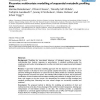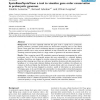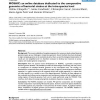BMCBI
2008
13 years 11 months ago
2008
Background: DNA microarrays contain thousands of different probe sequences represented on their surface. These are designed in such a way that potential cross-hybridization reacti...
BMCBI
2008
13 years 11 months ago
2008
Background: At intermediate stages of genome assembly projects, when a number of contigs have been generated and their validity needs to be verified, it is desirable to align thes...
BMCBI
2008
13 years 11 months ago
2008
Background: Modelling the time-related behaviour of biological systems is essential for understanding their dynamic responses to perturbations. In metabolic profiling studies, the...
BMCBI
2008
13 years 11 months ago
2008
Background: Microarray technology has unveiled transcriptomic differences among tumors of various phenotypes, and, especially, brought great progress in molecular understanding of...
BMCBI
2008
13 years 11 months ago
2008
Background: The availability of sequences from whole genomes to reconstruct the tree of life has the potential to enable the development of phylogenomic hypotheses in ways that ha...
BMCBI
2008
13 years 11 months ago
2008
Background: Formal classification of a large collection of protein structures aids the understanding of evolutionary relationships among them. Classifications involving manual ste...
BMCBI
2008
13 years 11 months ago
2008
BMCBI
2008
13 years 11 months ago
2008
Background: It has been repeatedly observed that gene order is rapidly lost in prokaryotic genomes. However, persistent synteny blocks are found when comparing more or less distan...
BMCBI
2008
13 years 11 months ago
2008
Background: The recent availability of complete sequences for numerous closely related bacterial genomes opens up new challenges in comparative genomics. Several methods have been...




